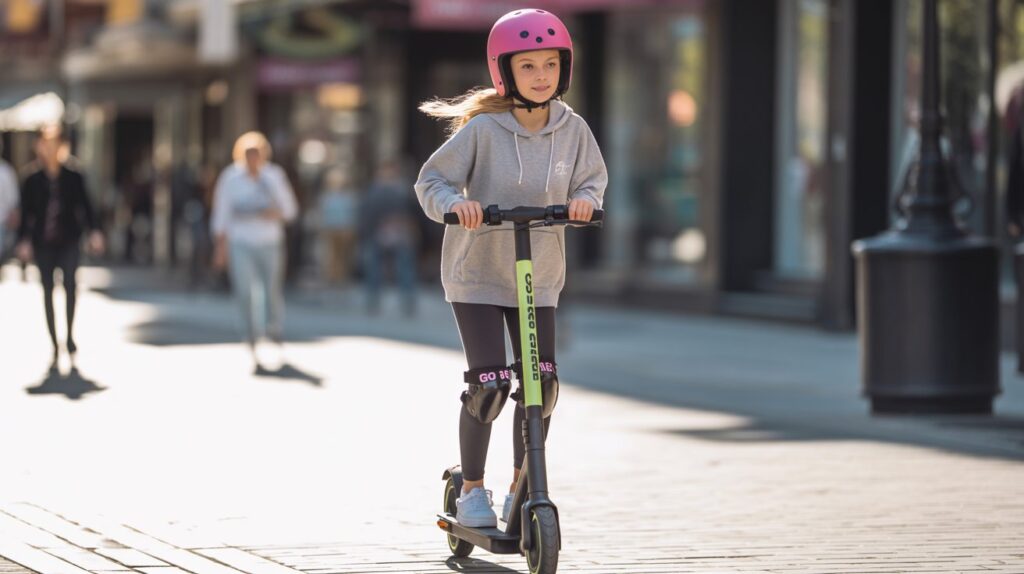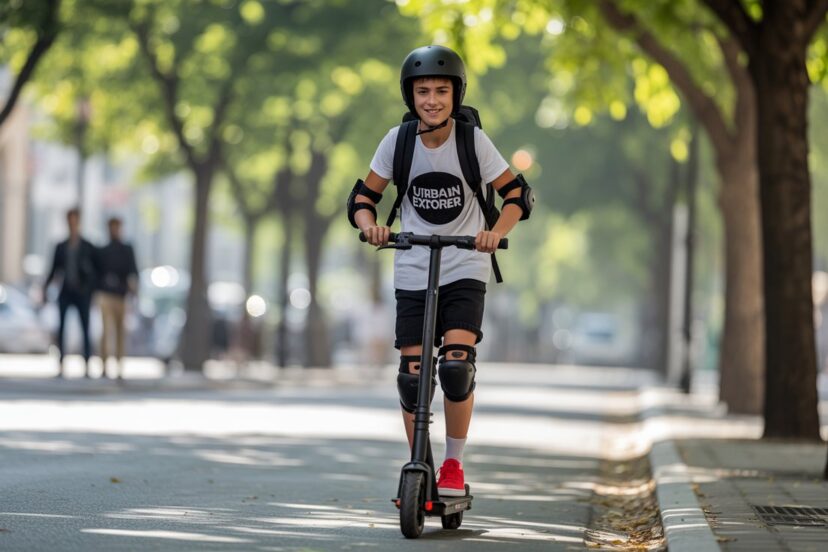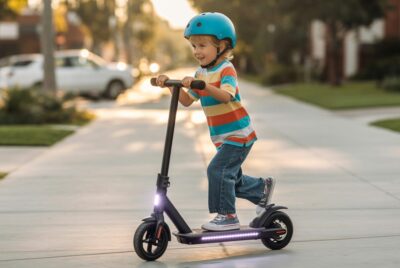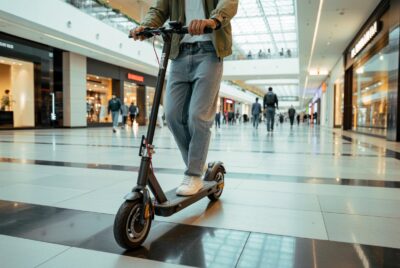E-Scooter Safety for Teens: What Parents Should Know
*We may earn a commission for purchases made using our links. Please see our disclosure to learn more.
The sun was setting on what should have been a perfect evening ride when a 16-year-old found themselves sprawled on the pavement, their e-scooter wheels spinning uselessly beside them. What started as a quick trip to meet friends had turned into a painful lesson about the importance of e-scooter safety. This scenario plays out far too often as electric scooters become increasingly popular among teenagers, offering freedom and convenience but also presenting unique safety challenges that demand serious attention.
“E-scooter injuries among teens have increased by 70% in the past three years, with most accidents being completely preventable through proper safety measures.”
– National Transportation Safety Board
Key Takeaways
- Wearing proper protective gear reduces injury risk by up to 85%
- Understanding traffic laws is essential for safe e-scooter operation
- Speed management and situational awareness prevent most accidents
- Regular scooter maintenance ensures optimal safety performance
- Responsible riding habits protect both riders and pedestrians
The Critical Foundation: Protective Equipment
Essential Safety Gear
The most transformative change any teen can make to their e-scooter experience involves embracing comprehensive protective equipment. A properly fitted helmet serves as the cornerstone of e-scooter safety, yet studies reveal that fewer than 30% of teen riders consistently wear head protection. The statistics paint a sobering picture: riders without helmets face a 300% higher risk of serious head injuries.
Beyond helmets, knee and elbow pads provide crucial protection during falls. Many teens initially resist wearing protective gear, viewing it as uncool or unnecessary. However, those who experience the confidence that comes with proper protection quickly discover that safety gear actually enhances their riding experience rather than diminishing it.
The Psychology of Safety Equipment
Understanding why teens often resist safety equipment helps address this challenge effectively. Peer pressure, perceived invincibility, and concerns about appearance all contribute to protective gear avoidance. Communities that have successfully improved teen helmet usage focus on education about real consequences rather than fear-based messaging, demonstrating how protective equipment enables more adventurous and confident riding.
Mastering Traffic Laws and Regulations
Understanding Legal Requirements
E-scooter regulations vary significantly by location, creating confusion for teen riders who may travel between different jurisdictions. Most areas require riders to be at least 14-16 years old, though some cities set higher age limits. Speed restrictions typically cap e-scooters at 15-20 mph, with many models allowing riders to adjust maximum speeds.
Traffic law compliance extends beyond speed limits to include proper lane usage, signaling requirements, and intersection navigation. Teens must understand that e-scooters occupy a unique space in transportation law, often subject to bicycle regulations while possessing capabilities that exceed traditional cycling.
The challenge of sharing road space with vehicles, cyclists, and pedestrians requires sophisticated judgment skills that develop over time. Teen riders benefit from structured practice in low-traffic environments before venturing into busy areas. Understanding right-of-way rules, proper positioning in traffic lanes, and communication with other road users prevents the majority of serious accidents.
Speed Management and Environmental Awareness
The Dangers of Excessive Speed
Speed-related accidents represent the leading cause of serious e-scooter injuries among teenagers. The combination of adolescent risk-taking tendencies and powerful electric motors creates a dangerous dynamic that requires careful management. Riders who maintain speeds appropriate for their skill level and environmental conditions dramatically reduce their accident risk.
Environmental factors significantly impact safe riding speeds. Wet pavement, poor lighting, crowded areas, and unfamiliar terrain all demand reduced speeds and heightened attention. Teaching teens to adjust their riding based on conditions rather than maintaining maximum speed regardless of circumstances proves essential for long-term safety.
Developing Situational Awareness
Effective e-scooter safety requires constant environmental scanning and threat assessment. Teen riders must learn to identify potential hazards well before they become immediate dangers. This includes recognizing pedestrian movement patterns, anticipating vehicle behavior, and understanding how weather conditions affect both visibility and traction.
The development of situational awareness skills takes time and practice. Parents and instructors can help by riding alongside teens initially, pointing out potential hazards and discussing decision-making processes in real-time. This mentoring approach builds judgment skills more effectively than theoretical instruction alone.
Maintenance and Mechanical Safety
Regular Inspection Routines
Mechanical failures contribute to a significant portion of e-scooter accidents, yet most are preventable through regular maintenance and inspection. Teen riders should develop habits of checking tire pressure, brake function, and battery levels before each ride. Understanding basic mechanical systems helps riders recognize when their scooter requires professional attention.
Tire condition particularly impacts safety, as worn or improperly inflated tires significantly increase accident risk. Brakes require regular adjustment and pad replacement, especially for frequently used scooters. Battery maintenance affects not only range but also power delivery consistency, which impacts rider control and safety.
When to Seek Professional Help
While teens can handle basic maintenance tasks, certain repairs require professional expertise. Electrical system problems, structural damage, and complex mechanical issues should always be addressed by qualified technicians. Teaching teens to recognize when problems exceed their repair capabilities prevents dangerous attempts at amateur fixes.

Addressing Common Safety Challenges
Peer Pressure and Risk-Taking
The social dynamics surrounding teen e-scooter use often encourage dangerous behaviors. Group rides can escalate into unofficial races or stunt competitions that dramatically increase injury risk. Addressing peer pressure requires helping teens understand that true confidence comes from skilled, controlled riding rather than reckless displays.
Building a culture of responsible riding within teen peer groups requires positive role modeling and clear communication about consequences. Communities with successful teen safety programs emphasize the social benefits of responsible riding, positioning safety-conscious riders as leaders rather than outcasts.
Weather and Environmental Challenges
Different weather conditions present unique safety challenges that teen riders must learn to navigate. Rain creates slippery surfaces and reduces visibility, while strong winds can affect scooter stability. Snow and ice make e-scooter riding extremely dangerous, requiring alternative transportation arrangements.
Night riding presents particular challenges for teen safety. Reduced visibility affects both the rider’s ability to see hazards and other road users’ ability to see the scooter. Proper lighting, reflective clothing, and route selection become crucial for safe night riding.
Building Responsible Riding Habits
Route Planning and Preparation
Successful e-scooter safety begins with thoughtful trip planning. Teen riders benefit from identifying safe routes that minimize high-traffic areas and dangerous intersections. Understanding alternative paths for different destinations builds confidence and reduces reliance on potentially unsafe shortcuts.
Preparation extends beyond route selection to include weather checking, battery level verification, and communication with parents or guardians about intended destinations and expected return times. These habits establish patterns of responsible decision-making that extend well beyond e-scooter use.
Communication and Emergency Preparedness
Teen riders should always carry communication devices and understand emergency procedures. This includes knowing how to contact emergency services, parents, and scooter rental companies when applicable. Understanding basic first aid principles helps riders respond appropriately to their own injuries or assist others in need.
Emergency preparedness also involves understanding when not to ride. Illness, fatigue, emotional distress, and substance use all impair judgment and reaction time, making e-scooter operation dangerous. Teaching teens to recognize when they’re not in appropriate condition to ride prevents many accidents.
The Broader Impact of Safety Culture
Community Integration and Respect
Responsible e-scooter use requires understanding and respecting community standards and expectations. This includes appropriate parking, yielding to pedestrians, and maintaining reasonable noise levels. Teen riders who demonstrate respect for their communities help build positive relationships that benefit all e-scooter users.
The integration of e-scooters into existing transportation systems requires compromise and mutual respect among all road users. Teen riders who model courteous behavior help establish positive precedents that influence policy decisions and community acceptance.
Long-Term Transportation Habits
The safety habits teens develop during their e-scooter experiences influence their approach to all future transportation choices. Young people who learn to prioritize safety, follow regulations, and consider the impact of their choices on others carry these values into driving, cycling, and other activities.
Building a foundation of responsible transportation behavior during the teen years creates lifetime patterns that extend far beyond e-scooter use. Communities that invest in comprehensive teen safety education see benefits across multiple transportation modes and age groups.
Practical Implementation Strategies
Gradual Skill Development
Effective e-scooter safety education follows a progressive approach that builds skills gradually rather than overwhelming new riders with complex information. Beginning with basic balance and control in safe, controlled environments allows teens to develop confidence before facing traffic challenges.
Skill development programs benefit from structured progression through increasingly challenging scenarios. This might include parking lot practice, quiet residential streets, bike path navigation, and finally supervised urban riding. Each stage builds upon previous learning while introducing new challenges at an appropriate pace.
Family and Community Support
Successful teen e-scooter safety requires support from families, schools, and communities. Parents who model responsible behavior and maintain open communication about safety concerns help reinforce positive habits. Schools that incorporate transportation safety into their curricula provide valuable reinforcement of home-based lessons.
Community support might include designated practice areas, safety equipment lending programs, and regular educational events. Local law enforcement partnerships help teens understand legal requirements while building positive relationships with authority figures.
Technology and Safety Innovation
Advanced Safety Features
Modern e-scooters increasingly incorporate safety features specifically designed to protect riders. Speed limiting capabilities, improved braking systems, enhanced lighting, and stability control systems all contribute to accident prevention. Teen riders should understand how to utilize these features effectively.
GPS tracking and emergency alert systems provide additional safety benefits, particularly for parents concerned about teen rider safety. Understanding the capabilities and limitations of these systems helps families make informed decisions about supervision and independence levels.
Future Developments
The e-scooter industry continues evolving with safety improvements driven by accident data and user feedback. Future developments may include automatic emergency braking, collision avoidance systems, and enhanced stability control. Staying informed about safety innovations helps teen riders take advantage of improved protection as it becomes available.
Conclusion
The journey toward comprehensive e-scooter safety for teens requires commitment, education, and community support. While the statistics regarding teen e-scooter injuries paint a concerning picture, the vast majority of accidents remain preventable through proper preparation, equipment use, and responsible riding habits.
The teenager who began this article sprawled on the pavement learned valuable lessons that transformed their approach to e-scooter safety. By embracing protective equipment, understanding traffic laws, developing situational awareness, and building responsible riding habits, they discovered that true freedom comes not from reckless abandon but from the confidence that accompanies skilled, safe operation.
The investment in comprehensive e-scooter safety education pays dividends far beyond accident prevention. Teen riders who develop these skills gain confidence, independence, and transportation options that enhance their quality of life while contributing positively to their communities. The goal extends beyond mere accident avoidance to the development of responsible, skilled riders who serve as positive examples for their peers and younger riders who will follow in their tracks.
Every teen who chooses to prioritize safety makes a difference not only in their own life but in the broader culture surrounding e-scooter use. The decisions made today by teenage riders will influence policy decisions, community acceptance, and safety standards for years to come. By embracing comprehensive safety practices, teen riders become part of the solution to the challenges facing the e-scooter community while enjoying all the benefits that responsible riding provides.
Frequently Asked Questions
1. What age should teens be to start riding e-scooters safely?
Most safety experts recommend that teens be at least 14-16 years old before riding e-scooters independently, with younger teens requiring adult supervision. The specific age depends on local regulations, individual maturity level, and riding environment complexity.
2. Is helmet use really necessary for short trips?
Yes, helmet use is essential for all e-scooter trips regardless of distance. Most accidents occur within the first few minutes of riding or during short, familiar trips when riders may be less cautious. Head injuries can occur at any speed and often result from unexpected obstacles or loss of control.
3. Can teens ride e-scooters in bike lanes?
Bike lane usage rules vary by location, but many areas do allow e-scooters in bike lanes. Teens should check local regulations and understand that bike lane riding requires following cycling traffic rules, including proper signaling, speed management, and yielding to other cyclists.
4. What should teens do if their e-scooter breaks down while riding?
If an e-scooter malfunctions during a trip, teens should immediately move to a safe location away from traffic, contact parents or guardians, and avoid attempting repairs. For rental scooters, contact the rental company’s emergency line. Never attempt to ride a malfunctioning scooter.
5. How can parents help ensure their teen’s e-scooter safety without being overprotective?
Parents can support teen safety by providing proper equipment, establishing clear rules and consequences, offering practice opportunities in safe environments, and maintaining open communication about challenges and experiences. GPS tracking apps can provide peace of mind while still allowing appropriate independence.




